Mighty Mite-y: Medication Round 2
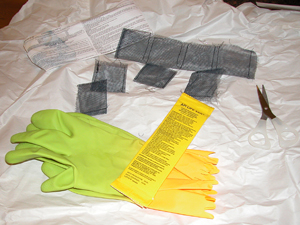
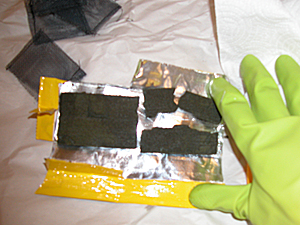
I have to medicate for Varroa mites, a pest that has made beekeeping much more difficult and chemical-oriented than it used to be. Even so, there are choices that seem less environmentally aggressive than others. I chose ApiLife Var, an approach that uses wafers that are infused with incredible concentrations of thymol (thyme oil), eucalyptus oil, and menthol (peppermint oil). As the oil vaporizes, it causes the mites to die without killing the bees. Unlike antiobiotic strips or formic acid (two alternatives), I have to place this medication in each hive 3 times.It's hard work, with the colonies all full of the complete weigfht of their not-yet-munched-on winter honey stores.
As benign as I would like this treatment to seem, those oil concentrations must never touch skin or eyes, and I need to take care that I do not leave smears of concentrated oil on my tools or work surfaces. So I take a toxic waste approach: I work on sheets of newsprint with gloves, next to the sink, with lots of paper towels already torn and at the ready should I wish to handle something (like the faucet or my camera). The photo at left shows my gear, plus little pockets sewn from aluminum window screen material. I need to encase the wafers in these envelopes to keep the bees from chewing the wafers or trying to get them out of the colony before they do their work. I sew them on my machine, and I showed you both stages in how I make them.
On the right is a (blurry) picture of the wafers inside an ApiLife VAR envelope. Each contains two wafers, made out of the same stuff as florist's foam. It is both squishy and breakable, and you can see that one tablet has fractured. This is OK, because I need to divide each tablet into 4 pieces and place each in its own screen envelope.
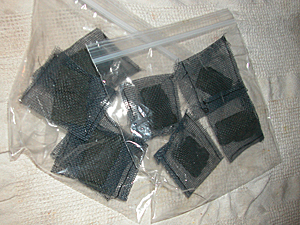
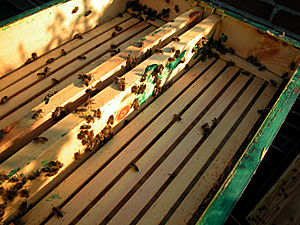
Here's are two ziploc bags with the screen packets inside, ready to head up to the roof in my pocket. Once the hives are opened and the honey stores are set aside, I need to place one envelope on each corner of the top of the brood nest. The fumes from the wafers will sink down over the part of the hive where the bees are hatched and raised – which is also the place where varroa attach themselves to larvae and breed their own nasty little ones.
On the right is a close up of the hive top feeder from the Wilde (smaller) colony. I put sugar syrup with a medication for Nosema (an intestinal ailment) in here last time, and was curious about whether the girls would take the feed well at this late season. It's all gone! The slats are designed to float on top of the sugar syrup, so bees won't drown. I have to pry them free when the feeder has been emptied because the girls start to glue them in place.
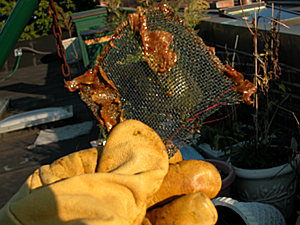
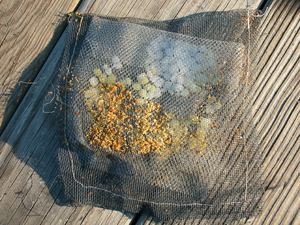
Bees throw out, glue down, or chew up everything that messes with their concept of "bee space" inside the colony. The ApiLife Var packet at left was placed in Wilde during my first round of treatment, and all that rusty brown guck is propolis: bee glue made primarily out of tree sap. It smells pretty good, actually. Everything inside does, and while working the hive it is not immediately evident that I have been vaporizing various essential oils in there.
On the right is one of the menthol packets that was placed at the bottom of the Wilde colony in September. It made my eyes water when I handled it then, though it hardly smells at all now. The stuff on top is what filters down from the colony: pollen chunks, drops of propolis, chewed up beeswax, and the odd fallen varroa mite. You can see that I put the menthol in a screen envelope, too, though it is several inches larger than the ApiLife VAR wafers.
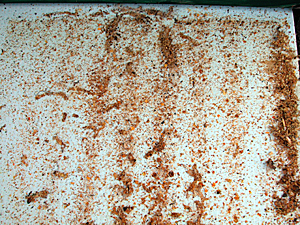
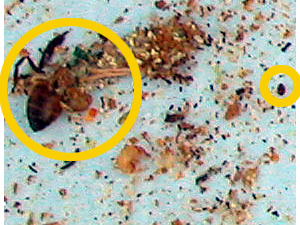
The wooden boxes that contain the frames of honey and the brood nest sit on a piece of woodenware called, not surprisingly, a bottom board. My bottom board has a screened section in the middle that allows better air flow and lets any mites that lose their footing fall clear out of the hive. There is a board (actually a piece of plastic) that I can slide in to cover the screen when I want to cut off air flow, like when there are medications in the hive that need to be concentrated over a period of time. The picture on the left is about half of the bottom board that I pulled out from under the Twain colony on Sunday. The lines you see reflect spaces between the frames that hang inside the boxes above. There are bits of bee and pollen and wax and mites and who-knows-what on there. Beekeepers often use the removable bottom board as a way of monitoring the mite populations in their colonies, but they usually prepare it with something that makes the mites stick. They also perform the test over a carefully measured increment of time. This board has been in for almost 6 weeks, far too long to be statistically useful, and it also carries mites that were knocked down by the first round of medication, also messing up the count.
But on the right is a close up from the lower left corner of the board picture. I circled a bit of bee butt to give you a reference for how big a mite is. The half-bee you see there is maybe 1/2 inch (or perhaps 1 cm) long. The smaller circle indicates a varroa mite. When I tried to pick up mites to look at under the microscope, it was hard to tell one from any other random dark bit, but it turned out that a real one just about matchs the tip of a pointy tweezer.
My hubby got into the act here. I tweezed a number of likely looking dots (from both colonies, they both had them, sigh...) and put them on a dish. You can see that two turned out to be varroa, one a bit of dirt, and the other might be a partial mite. The magnification on the left is 10x. On the right is a 60x closeup of the nasty beast, lit from the bottom so you can see its insides. The little legs are how it grabs a bee: you can see how it might miss and fall down when trying to grab onto a bee, given its lopsided shape and relatively short legs.
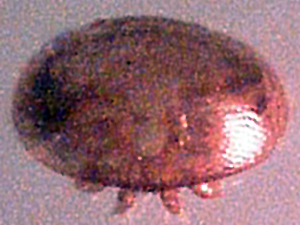
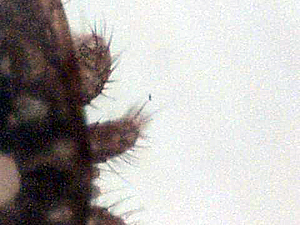
Megnified 60x and lit from the top, you can actually get a sense of the texture of its shell. The thing looks like a nightmare squid from Mars. You might notice an upright oval shape within the disk, above the legs. I believe that is the mouth which locks on the bee larvae and sucks out its blood. The final picture is a 200x close-up of the legs, not easy to get and the best we could do. I'm guessing those spines are used to attach to a bee and hold on until the mite can get itself into a brood cell and lock onto a larva.
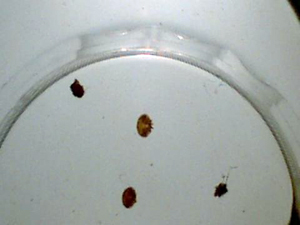
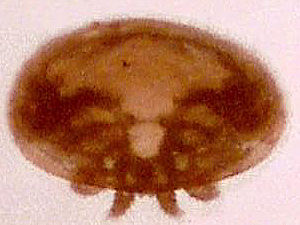
<< Home